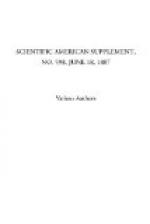In the 15th century a remarkable revival occurred in literature and the fine arts, showing a decided tendency to return to the old classic ideas of the Greeks and Romans. After an almost complete neglect, which lasted for centuries, artists and men of letters turned their attention to the long neglected relics of pagan civilization as worthy of study for their intrinsic beauty alone. Symbolism was relegated to a minor position, and beauty was once more cultivated for its own sake. This epoch is termed the Renaissance—which literally means a rebirth or revival.
1. Renaissance Style.—The term Renaissance is also applied to one of the early styles which came into vogue at this time. It flourished principally in southern Europe. It is not a pure style, but marks a transition period from the old popular Gothic and Saracenic forms to the revivified classic. It naturally exhibits a queer mixture of conflicting elements—classic and mediaeval thrown together without much regard to propriety or fitness. It still showed traces of symbolism.
2. The Cinquecento Style.—The Renaissance reached its most perfect development in the Cinquecento or the 15th century style. It followed the Quatrocento or 14th century style. Entirely untrammeled by symbolism, and with the whole field of classic and mediaeval ornament to glean from, its aim was to develop a perfect style of ornament. The best examples of this period are founded on the soundest principles of ornamental art. Nothing that could be turned into an element of beauty was neglected. Animals, real and fictitious, flowers, leaves, fruit, the human form, etc., were conventionalized and made to contribute their part to enhance the beauty of the whole. Some of the principal characteristics of the Cinquecento style are the delicate arabesque scroll work, the profusion and beauty of the curves, its admirable variations of standard classic ornaments, such as the anthemion and scroll. The coloring, also, was one of its most pleasing features. This style flourished principally in Italy and France. Farnese Palace and the tombs of the Medicis are noted examples.
3. The Louis Quatorze.—This style succeeded the Cinquecento, but was far inferior to it. It arose in Italy, and while preserving generally the materials of the style that preceded it, it added as characteristic features the scroll and the shell. Its principal object was to create brilliant and startling effects in light and shade. Color was, in consequence, decidedly secondary, gilding being used everywhere. The Palace of Versailles, near Paris, is a gorgeous example of this style. Everything in it is glittering and sparkling. Mirrors are everywhere placed to intensify this effect. This style was followed by the Louis Quinze, inferior to it in every respect, and in which symmetry, at least in detail, seems to be carefully avoided. It still further degenerated into the Rococo, the most extravagant and exaggerated of all the historic styles, and which prevailed in the latter part of the 18th and the beginning of the 19th century.




